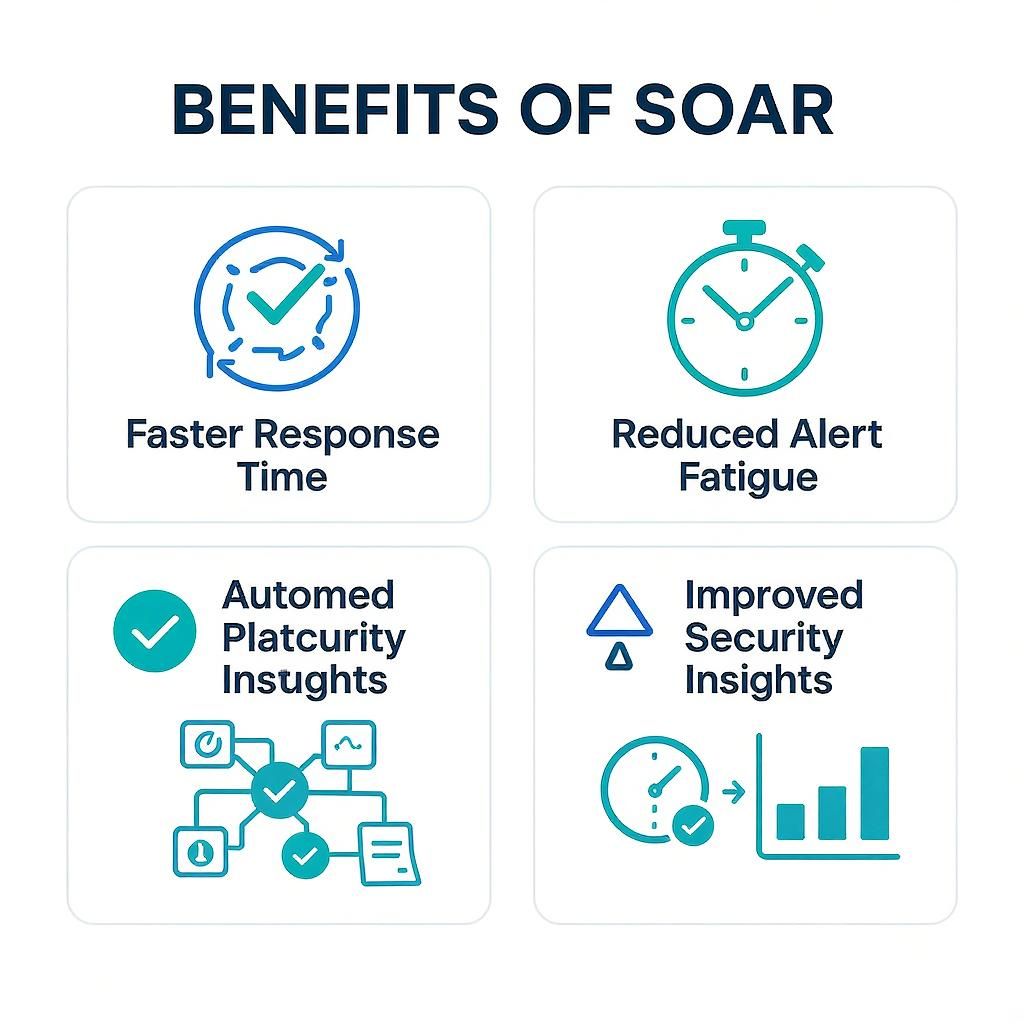Guide for security teams to detect, respond, and adapt faster
1. Introduction
In today’s cybersecurity landscape, alert fatigue has become a serious burden. Security operations teams often grapple with hundreds—or even thousands—of daily alerts. Sifting through this noise to find legitimate threats requires manual log reviews, tool juggling, and continuous cross-referencing. The result? Burnout, missed incidents, and slower response times.
Enter SOAR (Security Orchestration, Automation and Response): the game-changer every modern SOC needs. By orchestrating multiple tools, automating standard procedures, and intelligently managing incidents, SOAR platforms transform overwhelmed teams into proactive defenders.
As organizations scale, the need for the best SOAR solutions grows too. Whether you’re managing a mix of cloud and on-premise tools, drowning in alerts, or aiming for faster incident response, a proper SOAR platform can elevate your security maturity.
2. What Is a SOAR Platform?
A SOAR platform combines three key cybersecurity capabilities:
- Security Orchestration: Integrate diverse tools—EDR, SIEM, firewall, threat intel—into a unified workflow.
- Automation: Trigger actions (contain, isolate, notify) based on playbooks.
- Response: Execute containment, investigation, and remediation steps automatically or semi-automatically.
SOAR platforms also include:
- Playbook & Workflow Management: Documented processes that standardize response.
- Incident Tracking: Centralized case management for teams and auditors.
- Threat Intelligence Handling: Enrich alerts, prioritize true threats, separate false positives.
SOAR vs. SIEM
- SIEM acts as the eyes—collecting, analyzing, and alerting on security data.
- SOAR acts as the brain & hands—automating investigation, orchestration, and response across tools and teams.
While SIEM alerts you, SOAR helps you act—fast and accurately.
3. Key Features of SOAR Solutions
An effective SOAR platform offers robust features that empower SOC teams:
1. Orchestration & Integration
Seamlessly connects with EDR, firewall, SIEM, vulnerability scanners, email gateways, and ticketing systems—becoming the command center for incident workflows.
2. Playbook-Driven Automation
Pre-defined decision flows automatically validate, enrich, triage, and respond to incidents—minimizing manual intervention.
3. Incident Response Management
Tracks progress across investigations, manages tasks and assignments, and logs actions for audits.
4. Threat Intelligence Integration
Ingests indicators of compromise (IoCs), enriches alerts, helps triage, and suppresses noise.
5. Low-Code/No-Code Customization
Platforms like Swimlane and Tines enable analysts to build custom playbooks with minimal coding.
Want to dive deeper into cloud-native capabilities?
Check out our guide on SOAR for Cloud‑Native Applications.
4. Top-Rated SOAR Solutions in 2025
Here are eight standout SOAR platforms, based on peer reviews and ratings, perfect for different use cases:
• Swimlane Turbine
- Rating: 4.8 / 5
- Highlights: AI-enabled, low-code automation; ideal for MSSPs and SOCs.
- Best For: Teams wanting robust customization without heavy coding.
• FortiSOAR (Fortinet)
- Rating: 4.9 / 5
- Highlights: Deep orchestration with Fortinet products; scalable automation.
- Best For: Organizations embedded in Fortinet ecosystems.
• Tines
- Rating: 4.8 / 5
- Highlights: No-code workflow engine; rapid automation deployment.
- Best For: Teams seeking quick onboarding and modular playbooks.
• Splunk SOAR
- Rating: 4.2 / 5
- Highlights: Seamless integration with Splunk SIEM; extensive app ecosystem.
- Best For: Splunk users needing unified incident response.
• Cortex XSOAR (Palo Alto Networks)
- Rating: 4.6 / 5
- Highlights: Rich playbook library; intelligence-driven automation.
- Best For: Enterprises with diverse environments and toolsets.
• IBM Security QRadar SOAR
- Rating: 4.4 / 5
- Highlights: Advanced case management; end-to-end incident control.
- Best For: Large enterprises using IBM’s security stack.
• Torq Hyperautomation
- Rating: 4.7 / 5
- Highlights: Holistic “hyperautomation”; strong productivity features.
- Best For: Teams aiming for large-scale orchestration.
• InsightConnect (Rapid7)
- Rating: 4.2 / 5
- Highlights: Pre-built playbooks; integration with Rapid7 vulnerability tools.
- Best For: SMBs and Rapid7 users seeking simplicity.
Each tool is backed by trusted capabilities and peer praise. For cloud-first teams, explore our updated list of Top 5 Cloud-Based SOAR Solutions.
Would you like me to continue with sections 5–8, or adjust any part so far?
5. Choosing the Best SOAR Solution for Your Business
Every organization’s security posture is unique, and selecting the best SOAR solution depends on a careful evaluation of your specific needs, resources, and goals. Here’s what to consider before making a decision:
Key Factors to Evaluate:
- Scalability: Can the SOAR platform grow with your organization?
- Integration Ecosystem: Does it natively support your SIEM, EDR, cloud, and ticketing tools?
- Automation Capabilities: Look for low-code or no-code playbook builders and customizable triggers.
- Ease of Use: Your team shouldn’t need a programming background to build workflows.
- Deployment Type: Choose between on-premises, cloud-native, or hybrid deployments.
- Vendor Ecosystem Fit: If you’re already using platforms like Fortinet, Palo Alto, or IBM, a native SOAR solution from the same provider may simplify integration.
Want to go deeper into what makes a SOAR tool truly effective?
Explore our guide on Top 10 Features to Look for in a Cloud-Based SOAR Solution.
6. Benefits of SOAR in Real-World Environments
Implementing a SOAR platform isn’t just a technical upgrade—it’s a strategic leap for your entire security team. Below are the biggest advantages organizations experience once they deploy SOAR.

Reduced Alert Fatigue
By automating triage and eliminating low-risk alerts, SOAR allows analysts to focus on high-priority threats—restoring clarity and control in the SOC.
Faster Incident Response
SOAR drastically reduces Mean Time to Respond (MTTR) through automated containment, notifications, and remediation processes.
Increased Analyst Productivity
Analysts can spend more time investigating actual threats and less time doing repetitive, manual tasks.
Smarter Threat Prioritization
With built-in threat intelligence, SOAR tools can enrich alerts with context and prioritize them based on risk and relevance.
Streamlined Compliance & Audits
SOAR platforms log every action automatically, creating an audit trail that helps with regulatory requirements and post-incident reviews.
7. When Should You Adopt a SOAR Platform?
Not every organization starts with SOAR—but as complexity grows, most reach a tipping point. Here are signs it’s time to invest:
- Your team is overwhelmed with false positives and manual alert triage.
- Your SOC is growing, but hiring more analysts isn’t sustainable.
- You use multiple security tools that don’t talk to each other.
- Incident response is inconsistent or delayed.
- Your leadership is prioritizing cloud migration or digital transformation.
Curious where SOAR is heading in the next 2–5 years?
Read The Future of Cloud-Based SOAR: Trends, Predictions, and Opportunities.
8. Conclusion: Building a Proactive, Automated SOC
SOAR platforms aren’t just nice-to-have—they’re essential for scaling your cybersecurity maturity in a world where threats evolve by the second. The best SOAR solutions empower your team to work smarter, not harder.
By integrating tools, automating responses, and prioritizing real threats, SOAR turns alert chaos into operational clarity.
If you’re serious about reducing risk, accelerating response times, and unifying your tech stack, there’s no better time to explore SOAR platforms than now. Whether you choose an industry giant like Cortex XSOAR or a modern low-code solution like Swimlane, the right SOAR solution can redefine how your organization responds to threats.


